
Ahnfeltia fastigiata
Wiry Forked Seaweed, Bushy Ahnfelt’s Seaweed
15 June 2022
Fishboat Bay, Juan de Fuca Strait, B.C., Canada.
Tide: -1.0 feet at 09:32 PDT (measured at Sheringham Tidal Station)
Conditions: Mix of sun and cloud, wind variable 0 to 5 km/hour, sea calm to rippled, humidity 79%, 12˚C.
Moon: Waning Gibbous (97.4%, 16 days); Previous Phase, Full Moon, 14 June 2022 at 4:51am PDT: Next Phase, Third Quarter, 20 June 2022 at 8:10pm PDT.
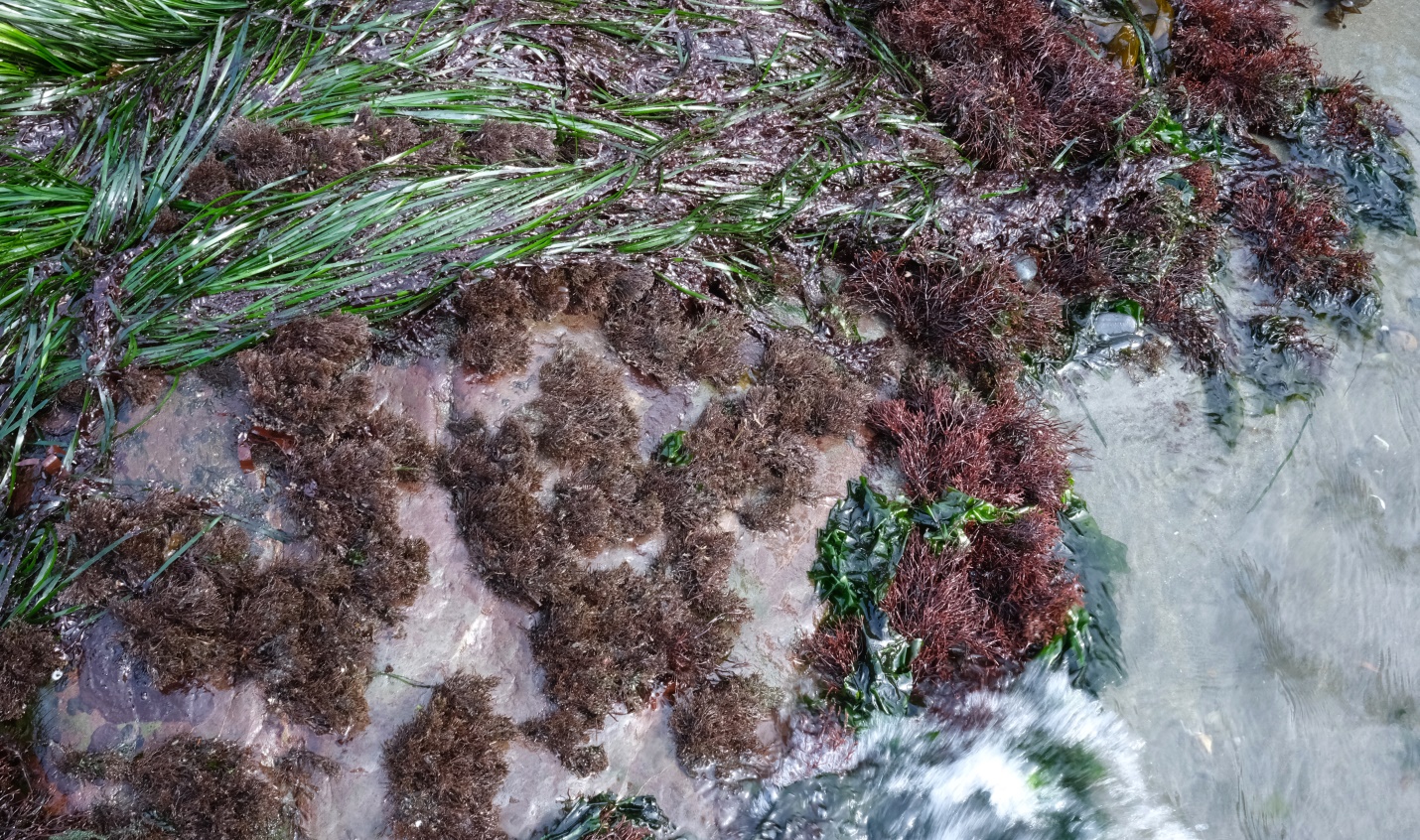
Figure 1: Wiry Forked Seaweed, also known as Bushy Ahnfelt’s Seaweed is pictured here on a wave swept boulder. It is growing amongst some surf grass and is neighbored by Cylindrical Forked Seaweed. Fishboat Bay, Juan de Fuca Strait, B.C., Canada. June 15, 2022. Photo ID: 27239 ©Seaweedwhisperings.com
Person 1:
Much of it growing near other “Forked Seaweed” species.
Growing a touch higher than others, perhaps giving it a sense of superiority. The reality may be that it can’t survive lower down, smothered by sand and dominated by its “cousins/siblings”.
See it as masculine, but as a child.
It’s the “little brother” of the other species.
Gets attention by being playfully annoying to its “siblings”, teasing and taunting.
Smiles mischievously.
Brat.
Looks disorderly and unkempt but close up you can see its regular dichotomous branching.
What we are seeing today is unusual. Likely due the loss of sand covering from big spring storms. Think it likes to be covered (safe) most of the time. Able to pop up once in a while to show itself and annoy, then retreat to safety before being attacked or made fun of…, easily humiliated.
Not as physically showy as the other Forked Seaweed species, so needs to be annoying to make its presence known.
Doesn’t care that it is perceived as annoying…, self-centered.
Hasn’t yet recognized its self-worth / value.
How Wiry Forked Seaweed gets attention (as seen from the perspective of others) – be over the top in:
Questioning incessantly.
Excelling at what they choose to do.
Purporting to know a lot (adolescence).
When doing my notes for this seaweed I found that I kept filling in or adding phrases.
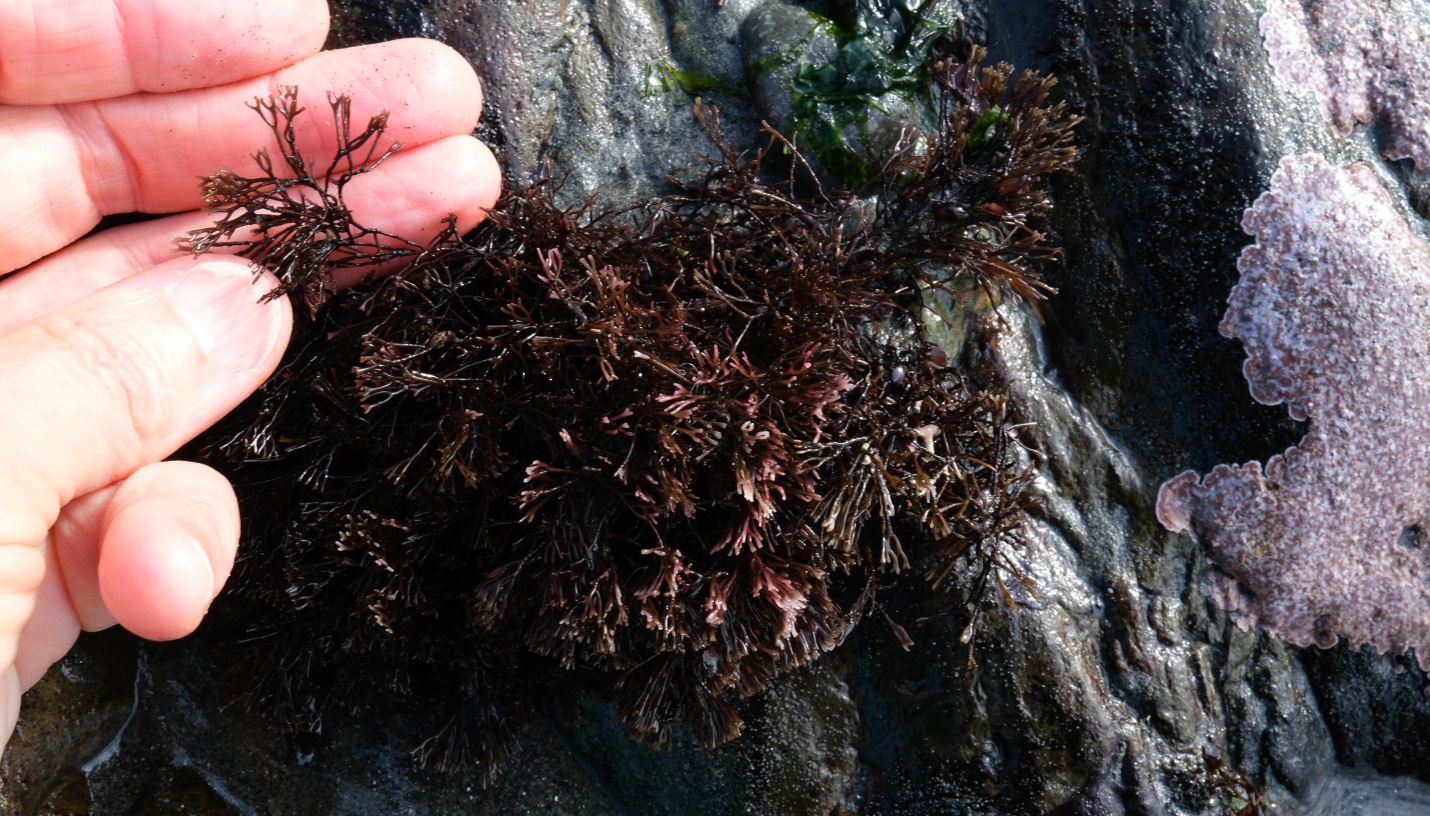
Figure 2: With a few sections separated out in hand, the relative size and the growth pattern of the branches of this seaweed are discernable. Fishboat Bay, Juan de Fuca Strait, B.C., Canada. June 15, 2022. Photo ID: 27240 ©Seaweedwhisperings.com
Person 2:
A minus one foot low tide this morning gives us the chance to visit the “wild side” of Fishboat Bay. Normally blocked by a rocky headland, at this very low tide we can explore here – a very special, wild and seemingly untouched-by-humans beach.
There are large boulders and outcrops here that have been eroded and polished smooth by the surf and sand.
Yes, the sand. There is a notable sand beach here and this mass of sand is a dynamic part of the topography/bathymetry, of this particular intertidal zone.
Where the tides and surfs and winds and ocean swells move the sand – inshore, offshore, down shore, alongshore, is always a meaningful variable to the life here and this particular spring, with a few highly unusual strong storms (high sustained winds at very low tide days), well, it seems clear that a bit more of the sand beach has been shifted offshore than is typical here at this season.
This has bared the rocks to a greater degree and exposed to view what is living on them.
Abundant here are sand tolerant species of macro algae including Sand-scoured False Kelp, Flat-tipped Forked Seaweed, Cylindrical Forked Seaweed and Wiry Forked Seaweeds. Yes, today it is easy to compare and contrast all three “Forked Seaweeds” commonly found in our area.
The smallest, Wiry Forked Seaweed (Ahnfeltia fastigiata), is the species of this trio that I’ve observed less often in the past.
Today I’m observing that Wiry Forked Seaweed generally grows just a bit higher in the intertidal zone than its close relative, Fredericqia decewii (Cylindrical Forked Seaweed). Where it grows in comparison to Ahnfeltiopsis linearis (Flat-tipped Forked Seaweed) seems to be a bit more variable, but generally these three seaweeds brought to mind the characters from the children’s story ‘Goldilocks and the Three Bears’. Papa Bear, Mama Bear and Baby Bear figure in the story as Goldilocks determines the significance of the relative sizes of their chairs, porridge bowls and beds.
Relative sizes…, something about that hits home for this seaweed. Wiry Forked Seaweed is definitely the ‘baby’ in physical dimensions.
Hence the strategy to grow a little higher on these rocks so that, since height / reach is an issue, at least some of the time the sand will have been swept away enough so that there is access to sunlight and therefore some photosynthesizing time.
You must have quite a relationship with / appetite for sunlight.
Do you constantly ‘practice’ accepting what light you’ve got?
It seems that circumstances much beyond your control allow or block the light, and yet you manage to have made this challenging habitat your home.
Do you battle with frustration with the sense of losing the light too soon when suddenly you are forced into a state of ‘inert slumber’ because you are buried entirely under the shifting sea-soaked sands?
Or do you quickly and gracefully switch off? Take a break…, and go into not doing much of anything at all?
Looking up close at your branching I see so many “switching points”, too. You branch dichotomously to a large number of levels, and growth is not tall between branching points, so you quickly become quite bushy indeed.
Also, notably in you, Wiry Forked Seaweed, I see that the diameter of your branches – from right down near your holdfast to up near your forked tips, the diameter is all the same.
So, yes, dichotomous, branching or dividing into two…, so it might be left or right, east or west, this way or that way, a fork in the road, but no ‘road’ is larger than another.
Is it true that they are equally ‘traveled’?
It feels to me that this is so; they all receive equal interest – east or west, this way or that. Equal interest, energy, attention, nourishment. And then comes the next set of forks, which in turn, receive equal exploration, investment, energy.
For a seaweed with overall dimensions that really are small in scale you have a remarkable number of branches, Ahnfeltia fistigiata.
I do wonder about all those branches; do you remember and retain as a part of you a recollection and access to all those different paths, all those different parts of you?
Do they all inform you simultaneously?
Are they all available to you for prompt recollection and current use?
Something tells me that this is not necessarily the case; that some branches / thoughts / ideas / past roads traveled / questions explored…, some of them are “lost” to you. There’s simply too many to “hold” all of them as current and accessible and readily at hand.
So maybe then it is good that you have some “buried under the sand” time. A time to rest, pause, leave things “in neutral” for a while.
Do you spend this buried under sand time in total repose? Or do you do a bit of dreaming…, a bit of quiet review that is not directed by any particular focus?
Yes, I think any purposefulness must be set aside at these times, and your sand-covered slumber brings with it some opportunities, too. The opportunities come once you switch over to and rest in the darkness and rest, trusting that light will be available to you again in due course.
I notice that some of the stems of Wiry Forked Seaweed have a “growth” on them. It looks ‘whitish’ in color, and has the look almost of a plaster of tiny tapioca pudding (small circular parts joined together to form a whitish coating) encircling the stem of Ahnfeltia. It actually does look like a clumsy plaster / cast / bandage around the stems of this small red alga.
And just like humans feel when living with a cast /plaster to immobilize a broken bone while it mends, I think this ‘white stuff’ bothers you, Ahnfeltia fistigiata. It really bothers and annoys you, but you are powerless to shake it off.
What is this relationship – between you and this whitish growth?
Could it be something other than bothersome? It seems that to find the positives in this is somehow not yet easily achievable for you, Ahnfeltia.
“Wiry” Forked Seaweed – yes, you have wiry look and you have a wiry strength.
Very flexible.
I can bend your stems very acutely and they don’t break.
I think if you tried to ‘grow’ much more flesh on your ‘bones’ – fill out any more than is essential, well, the sand would quite probably scour it away.
The sand that is part of your home environment aids in keeping you fit for this same environment. So ‘wiry’ comes to be a perfect form for where you live.
You grow here very near to Cylindrical Forked Seaweed, Frederiqia decewii, in many places. Interestingly I don’t sense that you really have much interaction with this neighboring alga.
Why is that?
Are you too busy with all your various branches of investigations to make time?
Are you pretty sure you wouldn’t “measure up” socially?
You’re certainly not as brightly colored nor nearly as visually attractive as Frederiqia and maybe you sense that others don’t really like your looks?
Or do you, even though you’re both “Forked Seaweeds”, do you ‘speak’ such a different dialect that you and Cylindrical Forked Seaweed can’t understand each other much at all?
Do you keep to yourself and avoid disappointments in trying to relate with others?
Are you clumsy at initiating interactions and so hold back?
Certainly it feels that you know how to keep busy and self-occupied, but I think there’s a bit of a longing there within you, too. What might it be like to interact pleasurably?
You also grow here in close proximity to each other; there are clusters of many Bushy Ahnfelt’s Seaweeds all near to each other on these medium sized boulders. It seems you make best use of the suitable habitat, but you don’t mix that much with your own species either.
Do you need to maintain a competitive edge?
Certainly you need a bit of space to spread your branches as you enlarge in breadth as much as you do in height when your branches multiply. You aren’t the type of macro alga that grows a long thallus that wafts in the ocean thereby taking advantage of ‘space’ that is much more abundant.
No, you keep yourself close to yourself. It’s a fairly tight and rather neat and tidy kind of arrangement.
At a certain size you might kind of ‘bounce’ off neighbors, but much of your core is within the perimeter of your overall ‘bushy’ form.
Where then can you ‘touch’ or be touched?
Where is interaction and input happening?
It seems this would be most likely to occur at all those tiny forked tips of yours and you have so very many of them. I wonder now, just how sensitive might those forked tips be?
Does ‘feeling annoyed’ really start with the physical for Ahnfeltia fastigiata?
Are they almost too sensitive for their own good? Do they get ‘swamped’ with sensory input at times and this then leads to imbalance at their core and also to behavior that is disorderly or unruly and quite often less than sociable?
Does being totally covered in sand, at some intervals for months at a time, give a kind of respite that is very useful and replenishing?
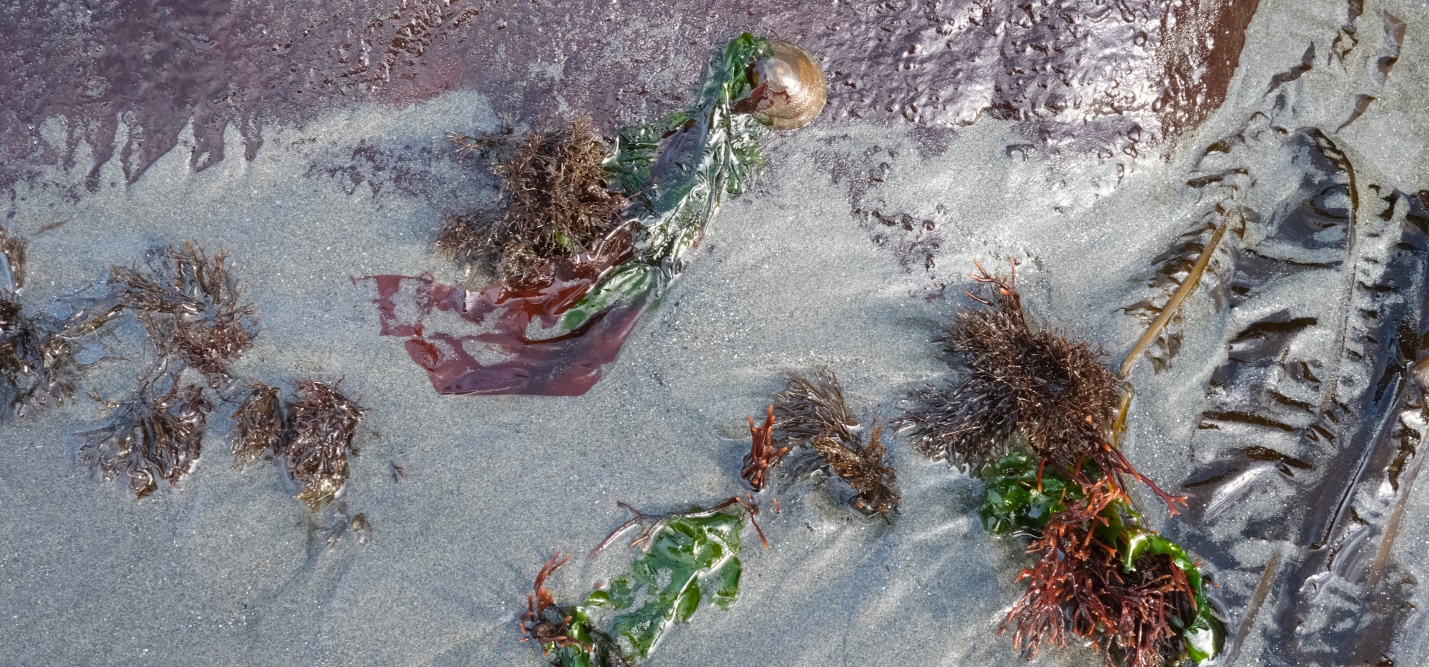
Figure 3: The dynamic interaction of this perennial seaweed with the sandy habitat is shown here. Several of the tufts of smaller, darker colored Ahnfeltia fastigiata are partially submerged in wet sand. Other algae and a fancily seaweed-adorned limpet are pictured, too. Fishboat Bay, Juan de Fuca Strait, B.C., Canada. June 15, 2022. Photo ID: 27241 ©Seaweedwhisperings.com
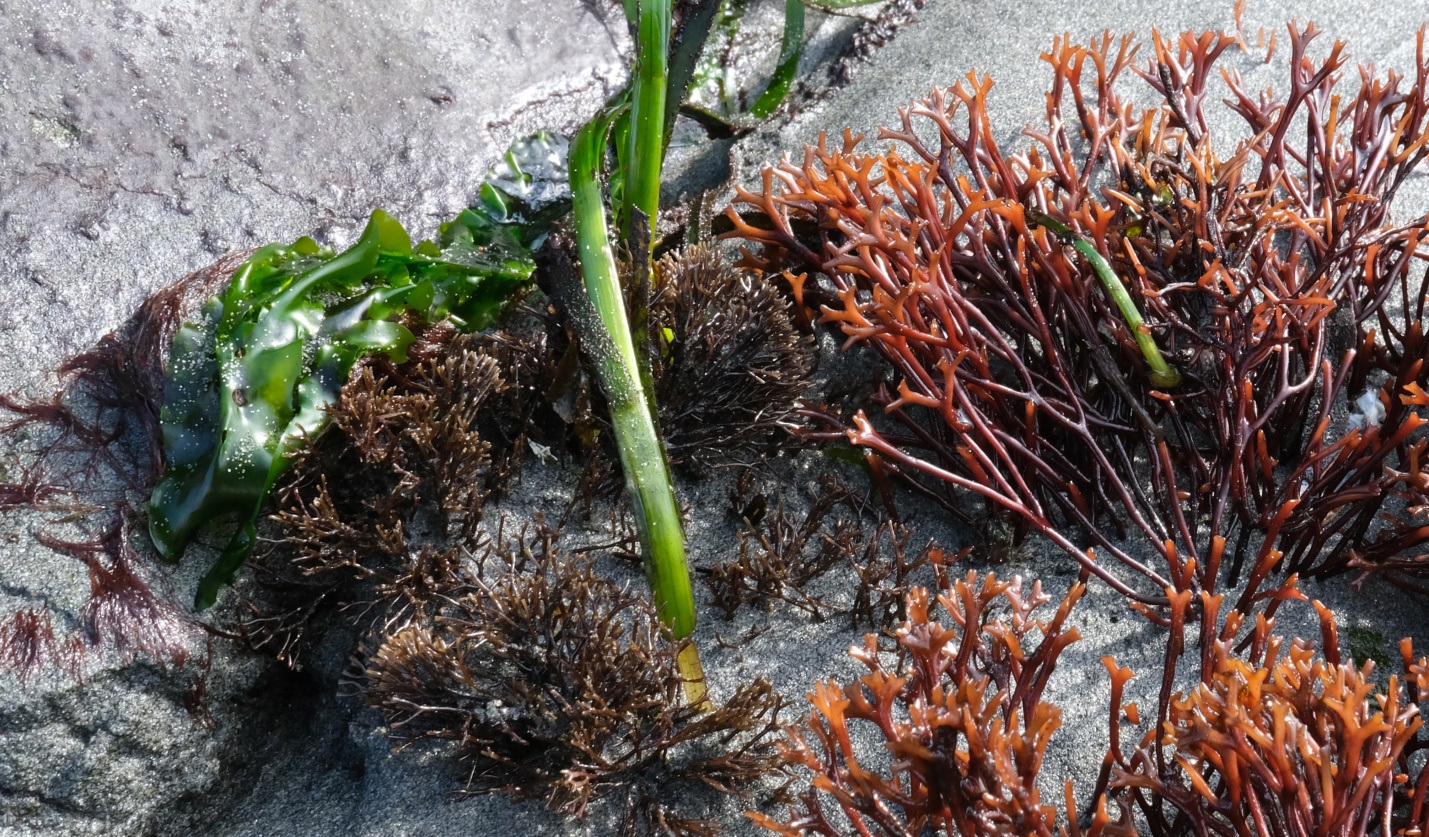
Figure 4: This closer view shows the relative sizes between “baby bear” and “mama bear” Forked Seaweeds. Fishboat Bay, Juan de Fuca Strait, B.C., Canada. June 15, 2022. Photo ID: 27242 ©Seaweedwhisperings.com
Discussion:
Person 1 found he connected mainly with one aspect of this seaweed’s nature – the annoying ‘younger brother’ who is a constant bother to those around him. He felt there was a strong reliance on this behavior to draw the attention of others. Person 2 recognized the annoyed feeling Ahnfeltia fistigiata has for the ‘whitish growth’ (later we learned that this is another seaweed, a coralline crust alga named Melobesia marginata) that is commonly epiphytic to certain species of red alga. With the presence of the epiphyte there is a persistent annoyance and irritation that cannot be shaken off. Person 2 also noted that annoyance may arise from sensory overstimulation – so many points of contact with the world seem evident in all the tiny forks of this seaweed’s ‘anatomy’. We chuckled to think of this theme of annoy or be annoyed; bother or be bothered. Certainly these are interactions that are not of the most satisfying nature. Possibly this aspect is a reflection of ‘age’ or maturity. Buried under sand for substantial periods of time, this alga grows only slowly – and possibly it matures slowly, too, or at least seems ‘behind’ in its maturity compared to faster growing macro alga. Buried in sand may also be the great ‘referee’ – calling a “time out” and providing a “cooling off” period – giving both time and separation to rebalance and soothe discord.
What community does this seaweed belong to then, if others are annoyed by it and it is annoyed by most others? What sort of pleasurable interactions and relationships are being missed? Is this like the situation of a self-satisfied recluse, or is it more the situation of a true misfit – everything is awkward and unfamiliar when relating with others. Again, it can be like Goldilocks who doesn’t really understand the ‘world of bears’ until she tests things out and learns from her mistakes. For a ‘misfit’ simple things are routinely misinterpreted and totally misunderstood and the common social understanding of peers is lacking. This makes repair of any misunderstandings unlikely, in fact it would build the evidence that the misfit truly doesn’t belong, and the formation of close relationships with others is therefore very difficult.
With Ahnfeltia’s multi-forked sensory input, it is quite possible that it is “picking up” data that is suggestive of one thing, while the social cues are trying to suggest something else. This is greatly confusing for one who is lacking in knowledge of social ‘norms’ and also potentially too revealing to those who hide behind social convention. It is possible to imagine a great deal of social difficulties inherent with this scenario.
The concept that Person 1 identified of this individual ‘gaining attention’ by being over the top in “excelling at what they choose to do” could put them firmly in the category of the “nerd”. Such a label indicates one who is seen as overly intellectual, obsessive (even introverted) and usually lacking in social skills. Actually most ‘nerds’ navigate some social interactions quite well, as long as they are within the confines of the subject of their ‘obsessions’. Many nerds are described as being shy, quirky, pedantic and unattractive. Those words fit well with many of the observations we made of this seaweed.
The quality of being ‘pedantic’ – this one resonated. The species name for this seaweed, ‘fastigiata’, has a fussiness to it and is similar to one of the synonyms for pedantic, that being ‘fastidious’. So, one who is over the top and excelling at something is often seen as over scrupulous, precise, over-exacting, perfectionistic, meticulous, literalistic, hypercritical and scholastic in their area of expertise. For individuals with such specialized interest, it is clear that it would be rather dissatisfying to interact with persons of little experience or interest in said subject. This puts in context the social isolation that may be preferred and commonly chosen in favor of social interactions of low common interest; these are often experienced as boring and can feel like ‘a waste of time’ due to the lack of meaningful stimulation.
One big aspect to this seaweeds nature is the impact of its sandy environment. With the constant shifting and movement of sand in the intertidal zone, the word “scour” stands out for Ahnfeltia. We thought to check the definitions in English for this word. There are three main meanings.
The first as a transitive verb is “to rub hard and remove with a rough material for the purpose of cleansing” or “to purge, remove dirt and debris from something” (and to become clean and bright by this cleansing/rubbing). There is even an archaic meaning “to clear a region of enemies”.
Also there can be a purging that is related to physical diarrhea or diseases such as dysentery (this is most commonly used in reference to livestock such as cattle and pigs). Scour as a noun can also relate to damage done by the scouring action.
And there is a final meaning in English use, where to scour means “to move quickly about in search” or “to go through and range over as if in search”.
It is interesting to think of this word, scour, and its meaning to Ahnfeltia fastigiata. As an algae growing where scouring is a regular event, this is a typical part of routine life. There is no possibility for impurities to hang on for much time, at least on the exterior, in that environment. But does Ahnfeltia also scour on the interior? If so, what is it searching for, and what is the haste?
There is also one more rather ‘big’ aspect to this seaweed which relates to its growth habit – ALL the tiny dichotomously forked branches. If you start with one branch and it divides and grows two more, and then those two forks each grow two more, and those four forks each grow two more…, after this happens five times you have thirty-two forked tips. After this happens ten times, you have one thousand and twenty four forked tips. If this continues to fifteen times, you then have a massive thirty-two thousand, seven hundred and sixty-eight individual forked tips!! ‘Bushy’ sounds like somewhat of an understatement with these numbers!
It came up in this Whispering to wonder how connected all these forks are each to one another or to the ‘whole’. How possible is it to hold all the ‘learning/knowledge/experience’ from each little branch that becomes a part of the whole ‘bush’. Would this seaweed even try to do that? Yes, it seems it does try to do that and the success of that endeavor feels like it may really be a matter of degree. If there is branching to five levels that seems easily manageable to keep track of. Possibly even to about eight levels, which would be two hundred and fifty six connected little ‘parts’, it feels like at this level competence can be quite high. But then numbers get very big, very fast. It seems hard to imagine, even if the ‘wiry’ nature of this alga was like some super conductive metal that speeds transmission, well, when you’ve got two thousand and forty-eight parts making up a whole…, it will probably be the only most recent or the stronger of the ‘parts’ that can be ‘present and accessible’ readily. Or is this line of thinking simply our bias imposed on another life form, that we would conclude these numbers are too big, that the possibility is too remote? Maybe there are only certain conditions / changes of state that cut back on optimal functioning for Ahnfeltia fastigiata…?
It seems that in this seaweed it is possible to switch over into overwhelm; overwhelming numbers of parts that can’t be connected in a linear or logical fashion with speed and without confusion or error. It’s like there are a very large number of “balls in the air” that for some reason, at certain times, can’t all be juggled successfully and with ease any longer. The overwhelm can push one into frustration and a fear of falling only further and further behind. If this overwhelm state is prolonged, a type of resignation can occur and with that the reluctance to do anything. There can be the feeling of “What’s the point of continuing, catching up is impossible!” These are quite the extremes – “balancing numerous (thousands) balls in the air” or “doing nothing”. Are there not many places somewhere in between those extremes and why does that seem so inaccessible to Ahnfeltia?
Overwhelm has some interesting synonyms including – swamp, bury, inundate, clog, saturate, flood, submerge. Ahnfeltia fastigiata’s habitat features these concepts regularly! It must be the perfect “training ground” to learn to work with overwhelm. Maybe this is also where the ‘relative size’ of things comes in again – Baby Bear, Mama Bear and Papa Bear; yes, there are many things to choose amongst but Ahnfeltia possibly could do well to remember to ‘size’ these options. Size them as in “to sort, categorize or classify”. And also with this categorization, be cognizant of from what inner motivation the sorting and choosing is arising. With what goals does it align – ego, or something else?
It seems that for the Ahnfeltia type of energy the challenge is to see when you are becoming overwhelmed and then to try to employ another tactic. Yes, maybe it is impossible to juggle all those balls at once, so instead of dropping them all by going into a “do nothing” state, decisions need to be made, often quickly, priorities must be chosen, wisely. Possibly intuition needs to step in and inform and then Ahnfeltia can confidently carry on with certain ‘balls’ while gently allowing some others to fall back into a kind of “ready inactivity”. What ‘calls’ the strongest is what may best be contemplated and attended to at that time. There will always be another day, many other times and countless numbers of balls to choose from.
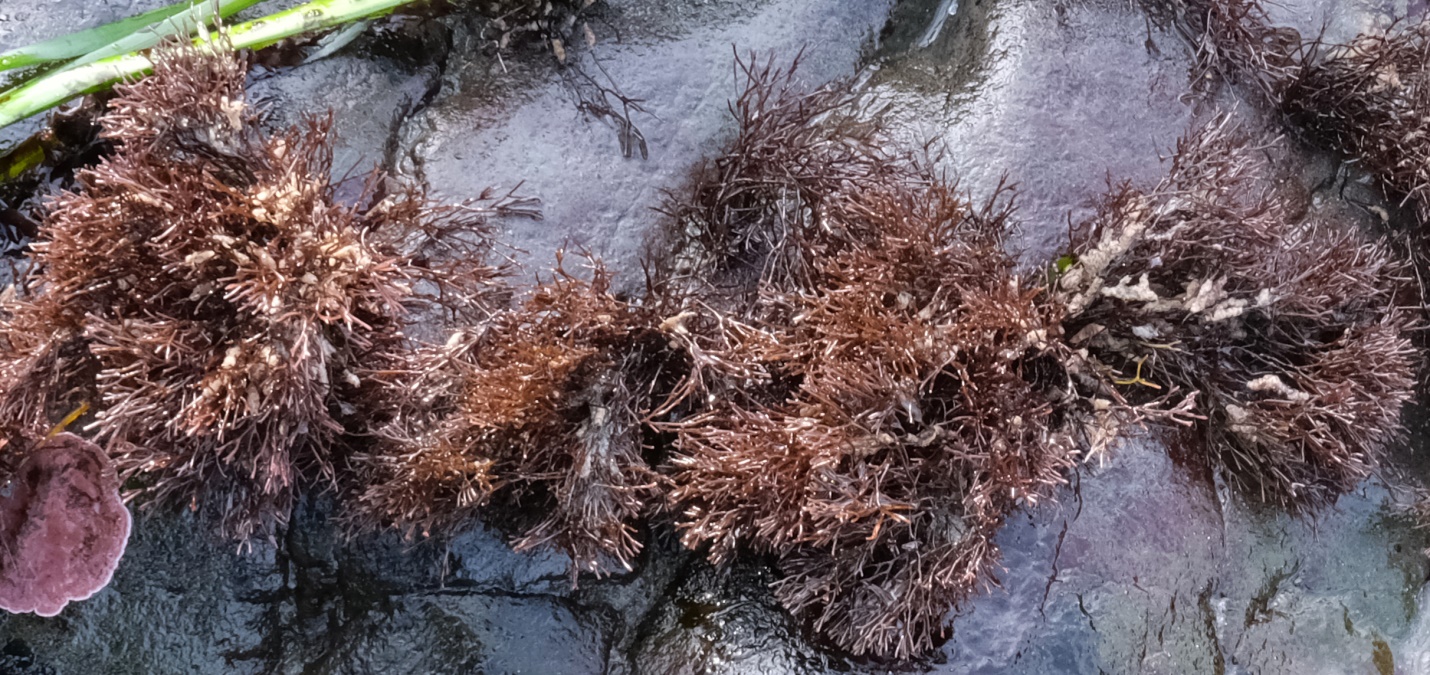
Figure 5: Technically not suitable for greater enlargement, this photo depicts the look of many Ahnfeltia fastigiata ‘bushes’ that are hosting another epiphytic seaweed, Melobesia marginata. The M. marginata alga is the whitish looking ‘growths’ that are clustered around the lower portions of the thalli of Wiry Forked Seaweed. Fishboat Bay, Juan de Fuca Strait, B.C., Canada. June 15, 2022. Photo ID: 27243 ©Seaweedwhisperings.com
Biology & Natural History Information:
Description:
Thallus of this perennial red alga is wiry in texture and dark reddish-purple to black in color. It grows in bushy tufts to 15 cm tall. Branches are thin, cylindrical in cross-section and range between 0.25 to 0.5 mm in diameter. They grow in a repeatedly dichotomous branching pattern. Reproductive structures (looking like small knobs) are scattered along the branches.
Bushy Ahnfelt’s seaweed is often associated with the larger loosely-branched Loose Ahnfelt’s Seaweed (Frederiqia decewii, formerly Ahnfeltiopsis gigartinoides) and, from Southern BC south, the even larger Flat-tipped Forked Seaweed (Ahnfeltiopsis linearis). Loose Ahnfelt’s Seaweed, also stiff and cylindrical in cross-section, could be mistaken for Bushy Ahnfelt’s, but is obviously larger and less wiry: its branches are 1 mm in diameter and it reaches 25 cm tall.
Habitat:
This tough perennial is slow growing and is found on rock, commonly associated with sandy habitats, of semi-exposed to semi-protected areas. It can be found in low to mid intertidal pools or in the exposed low intertidal regions and then sub-tidally on down to depths of 8 meters. It can survive while covered in sand for a substantial amount of time.
North Pacific Distribution:
Ahnfeltia fastigiata grows on both sides of the North Pacific, from northern Baja California north to the Aleutian Islands and the Bering Sea, west to the Kuril Islands and Kamchatka in Russia, and south to Japan and Korea.
Remarks: The type locality is Sitka, Alaska, USA (based on Gigartina fastigiata Postels & Ruprect 1840). Origin of the species name is from the Latin (adjective), fastigiate – with branches clustered, parallel and erect, giving a narrow elongated habit (occasionally meaning branched reaching to the same height) (Stearn 1973).
Classification:
Phylum: Rhodophyta
Class: Florideophyceae
Order: Ahnfeltiales
Family: Ahnfeltiaceae
Genus: Ahnfeltia
Species: Ahnfeltia fastigiata (Endlicher) Mackienko 1970
Former name(s): Chondrus fastigiatus Endlicher 1843 & Gigartina fastigiata Postels & Ruprecht 1840.
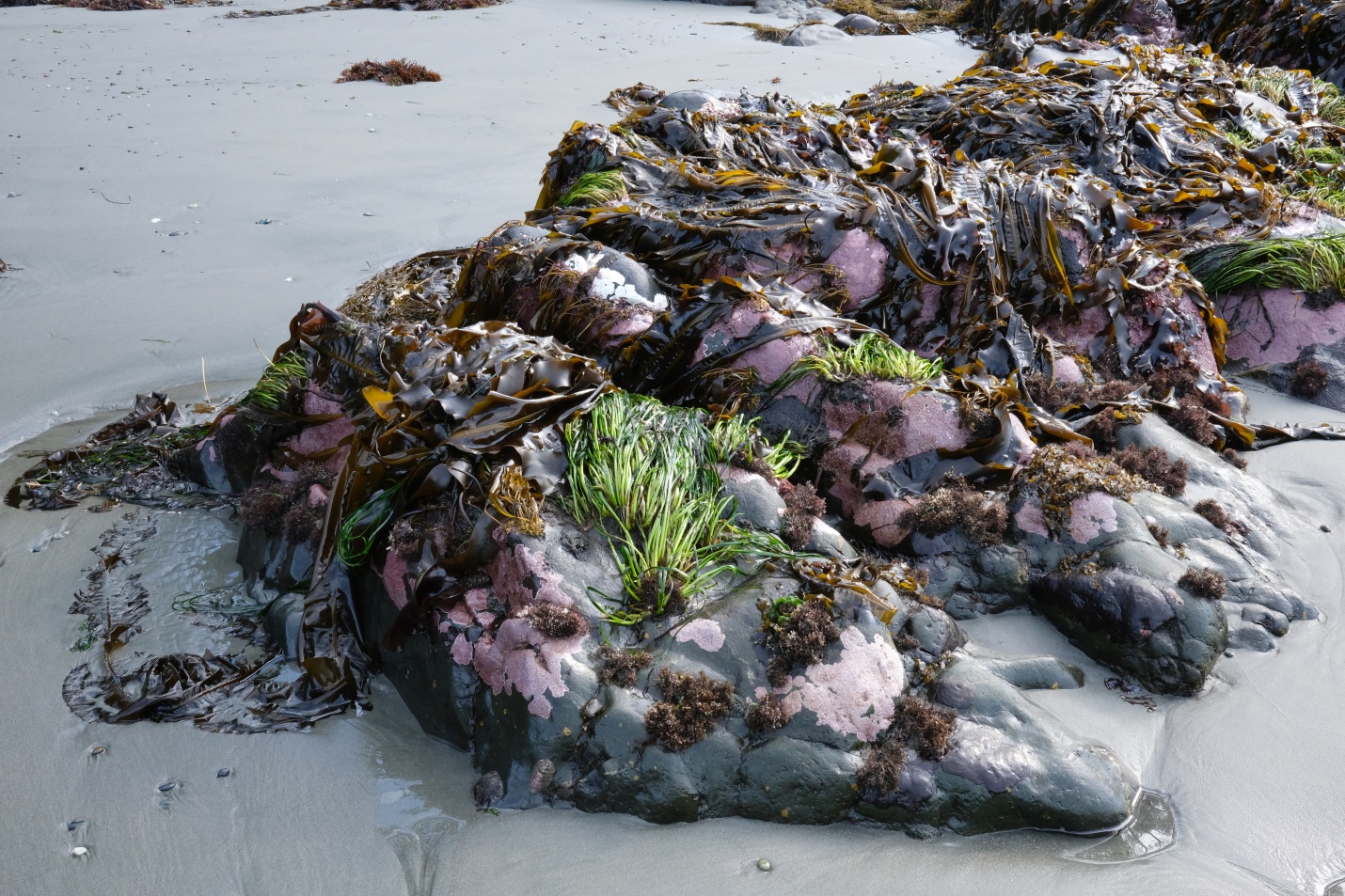
Figure 6: Yes, that’s Wiry Forked Seaweed in there – it is the brownish tufts or bushy growths of algae that are visible lower down on these sand eroded and sand surrounded boulders. This scene depicts the kind of habitat that Ahnfeltia fastigiata thrives in, although it is one you’d only witness at very low tides and for only brief intervals of time. Fishboat Bay, Juan de Fuca Strait, B.C., Canada. June 15, 2022. Photo ID: 27244 ©Seaweedwhisperings.com
![]()